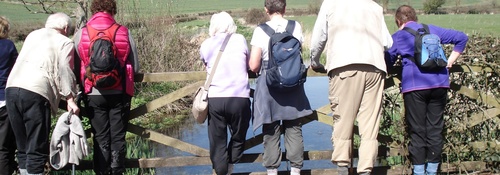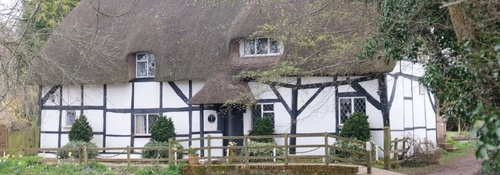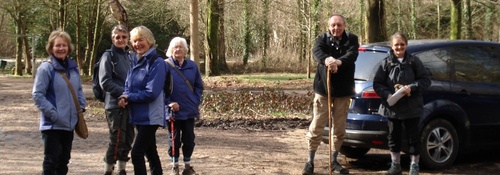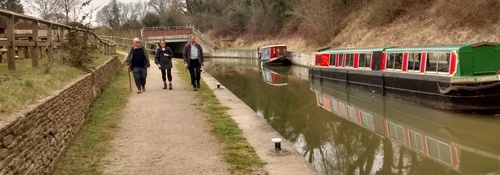Gallery
-
Milland morning walk 20th April 2016

Mary and Barbara's walk near Milland and the Maysleith woods, with lunch in The Rising Sun. This walk was postponed from earlier muddy days and was rewarded with sunshine.
The Maysleith House was one of Hugh Gaitskell's homes from 1941. He is remembered for introducing prescription charges for glasses and dentures to help pay for the Korean war - let's hope it ends soon.... It's not all bad - he did formally open Milland Village Hall in 1948, which happened to be a converted chicken shed at that time. However, he sold Maysleith in 1957, probably to spend more time on being Leader of the Labour Party and unfortunately on some ill-advised friendships. Said by some to be the best Labour Prime Minister the country never had.
Tichborne Day walk 13th April 2016

Denis's walk from Cheriton recreation field car park to Tichborne Arms. Very pleasant walk over beautiful Hampshire countryside with clear chalk streams filled with trout. Very warm day and Tichborne Church was as special as ever. Lunch in the garden of the Tichborne Arms was delightful. Thanks to Marian and Jane for additional photos.
The Church of England church of St Andrew also contains the private Roman Catholic Chapel of the Tichborne family.
There is much to be written about the Tichborne family which must rank amongst the great families of Hampshire. They can claim a heritage that is documented as far back as the C12th. All through the Reformation, the Tichborne family clung to their Roman Catholic faith. So did many others and were persecuted for it. Any hint of Catholicism in parish churches was removed and that is why the Tichborne Family Chapel is an extraordinary thing. The chapel is a rare Roman Catholic chapel inside a pre-Reformation church. It’s survival is incredible and there are only another two in England.
To survive the Reformation, the family must have been in high favour with their monarch. Sir Benjamin Tichborne, High Sheriff of Hampshire 1579 – 1580 showed great loyalty to his monarchs and was granted a concession in 1621 by King James I, in appreciation of Sir Benjamin’s help in securing Hampshire for the king at his accession in 1603. Thanks to www.hampshire-history.com for this information.
Alresford morning walk 6th April 2016

Peter's short walk around Alresford, starting at the Railway Station.
The section of line from Alresford to Alton that can be seen today was purchased from British Rail in November 1975. Reconstruction of the line subsequently progressed in stages. The section between Alresford and Ropley re-opened on 30 April 1977. To provide engineering and maintenance facilities, the main locomotive shed and workshops were constructed at Ropley. The extension to Medstead & Four Marks opened on 28 May 1983 and the final section to Alton opened on 25 May 1985.
Some of the structures that can be seen on the Watercress Line today were not part of the original railway infrastructure; they have been added to make the line serviceable again and to recreate the feel of a fully operational steam railway. The line is now maintained by a small base of paid staff (mostly in administrative duties) and a core of over 400 volunteers. Thanks to www.Wikipedia.org for this information. Legacies and contributions to Mid Hants Railway Ltd 'Watercress Line' The Railway Station, Alresford, Hampshire, SO24 9JG
Eartham and Stane Street 30th March 2016

Isabel's walk including the Slindon Estate Gumber Farm with lunch at The George at Eartham.
All photos thanks to Marian!
Gumber Bothy is a converted traditional Sussex barn maintained by the National Trust. When the barn was converted into bunkhouse accommodation many years ago local craftsmen were used and the renovations were done so sympathetically. Many of the original features remain today including the old timber beams.
To preserve the peaceful environment of the bothy and surrounding Slindon Estate there is no vehicle access to the site. Walking, cycling and riding to the bothy is very much encouraged and thus visitors carbon footprint is kept to a minimum. Secure bicycle storage is provided, as is accommodation for horses by prior arrangement. Although at present there is no solar power or methods in place to reuse rain water (plans have been discussed for the future) the bothy impacts little on the environment. Due to the simplicity of the building, there are no power sockets just light switches; the energy used is kept to a minimum. Information thanks to www.our-land.co.uk
Loxwood canal walk 23rd March 2016

Paul's very pleasant walk along part of the Wey & Arun canal, also known as London's lost route to the sea.
We heard one of the first chiffchaffs of spring singing near Devil's Hole Lock. Trust he spent a pleasant winter in the Mediterranean.
Sometimes a bit muddy but a flat 5 mile wander from Loxwood. Back to the Onslow Arms where the girl behind the bar deserved a medal as she coped with walkers and cyclists en masse.
In the 19th century it was possible to travel by boat from London to Littlehampton on the south coast of England via Weybridge, Guildford, Pulborough and Arundel. This was just part of a once-extensive system of inland waterways covering England and Wales.The route was via the rivers Wey and Arun, linked betweenShalford in Surrey, and Pallingham in Sussex, by the 23-mile Wey and Arun Canal.Although only one part of an extensive system, the Wey and Arun Canal formed a vital link, the only one between the south coast and the Thames, linking London and the busy river Thames with the English Channel - and beyond.
River Arun, c1900.The river Wey was made navigable from Weybridge to Guildford in 1653, and extended to Godalming 90 years later. The Arun has existed as a tidal navigation as far inland as Pallingham Quay, near Pulborough, since 1575. Thanks to www.weyandarun.co.uk for this information
Recent galleries
- Tilford Rural Life Centre on 16th July 2025
- Duncton walk on 9th July 2025
- Funtingdon on 2nd July 2025
- East Dean walk on 25th June 2025
- Itchenor walk on 18th June 2025
History
2025
2024
- December (3)
- November (5)
- October (4)
- September (4)
- August (4)
- July (4)
- June (5)
- May (5)
- April (5)
- March (5)
- February (5)
- January (4)
2023
- December (3)
- November (6)
- October (5)
- September (5)
- August (3)
- July (4)
- June (6)
- May (5)
- April (4)
- March (5)
- February (4)
- January (4)
2022
- December (4)
- November (5)
- October (5)
- September (3)
- August (4)
- July (6)
- June (11)
- May (4)
- April (5)
- March (4)
- February (5)
- January (4)
2021
2020
- December (4)
- November (1)
- October (5)
- September (4)
- August (3)
- July (3)
- March (2)
- February (5)
- January (3)
2019
- December (2)
- November (5)
- October (4)
- September (3)
- August (4)
- July (4)
- June (11)
- May (5)
- April (4)
- March (3)
- February (5)
- January (5)
2018
- December (2)
- November (4)
- October (4)
- September (5)
- August (4)
- July (3)
- June (5)
- May (8)
- April (4)
- March (4)
- February (5)
- January (3)
2017
- December (3)
- November (5)
- October (3)
- September (4)
- August (4)
- July (4)
- June (11)
- May (4)
- April (4)
- March (3)
- February (4)
- January (5)
2016
- December (3)
- November (4)
- October (5)
- September (4)
- August (3)
- July (6)
- June (11)
- May (4)
- April (5)
- March (3)
- February (10)
- January (2)
2015
2014
- June (2)
1997
- February (1)
